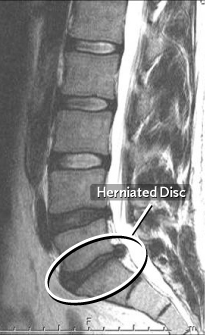A herniated disc, also called a ruptured disc or slipped disc, occurs when the inner core (nucleus pulposus) of the spinal disc pushes out through the outer layer (annulus fibrosis) of the disc. Some what like the jelly oozing out of a jelly donut. This tear in the outer layer causes pain in the back at the point of herniation. If the protruding disc presses on a spinal nerve, the pain may spread to the area of the body that is served by that nerve, such as the leg or arm.
Symptoms
Usually, the main symptom is sharp, acute pain. In some cases, there may be a previous history of localized low back pain, with pain also extending down the leg served by the affected nerve. This pain is usually described as a deep, sharp pain, which gets worse as it moves down the affected leg. The onset of pain with a herniated disc may occur suddenly or it may be preceded by a tearing or snapping sensation in the spine, which may be attributed to a sudden rupture in the annulus fibrosis.
Diagnosis
A patient with a herniated disc will usually complain of low back pain that may or may not radiate into different parts of the body, such as the leg. They will often demonstrate a limitation in range of motion when asked to bend forward or lean backwards, and they may lean to one side as they try to bend forward. Patients will sometimes walk with a painful gait, flexing the affected leg so as not to put too much weight on the side of the body that hurts. Straight leg raising may be a positive indication of tension on the nerve root.
Abnormalities in the strength and sensation of particular parts of the body that are found with a neurological examination performed by a doctor provide the most objective evidence of nerve root compression. An MRI is the test of choice for diagnosis of a herniated disc, but a CT scan (CAT scan) also may be helpful because it provides better visualization of the bony anatomy of the spinal column that indicates where the source of pressure on the nerve root is located.
Treatment
Most patients will respond to conservative therapy, such as medication, rest and physical therapy. If however conservative treatment fails to adequately relieve the symptoms of pain, numbness and weakness your neurosurgeon may determine that surgery is the best treatment for your individual condition. Your neurosurgeon will discuss with you the risks and benefits of surgery with you and answer any questions you may have.
Surgical Treatments


